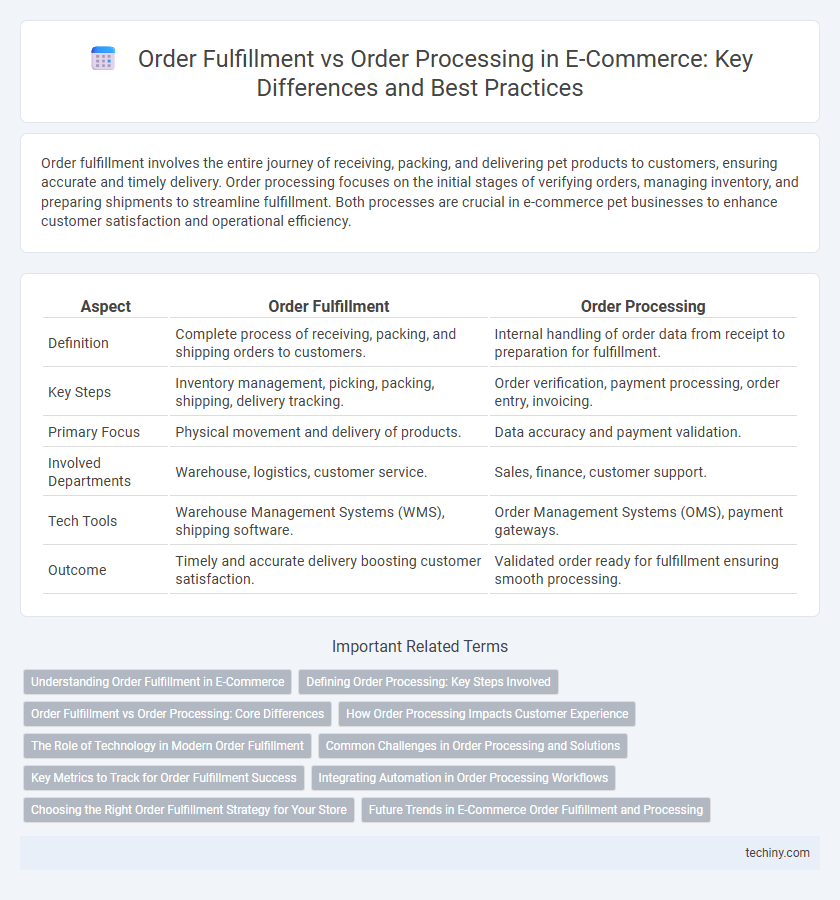Order fulfillment involves the entire journey of receiving, packing, and delivering pet products to customers, ensuring accurate and timely delivery. Order processing focuses on the initial stages of verifying orders, managing inventory, and preparing shipments to streamline fulfillment. Both processes are crucial in e-commerce pet businesses to enhance customer satisfaction and operational efficiency.
Table of Comparison
| Aspect | Order Fulfillment | Order Processing |
|---|---|---|
| Definition | Complete process of receiving, packing, and shipping orders to customers. | Internal handling of order data from receipt to preparation for fulfillment. |
| Key Steps | Inventory management, picking, packing, shipping, delivery tracking. | Order verification, payment processing, order entry, invoicing. |
| Primary Focus | Physical movement and delivery of products. | Data accuracy and payment validation. |
| Involved Departments | Warehouse, logistics, customer service. | Sales, finance, customer support. |
| Tech Tools | Warehouse Management Systems (WMS), shipping software. | Order Management Systems (OMS), payment gateways. |
| Outcome | Timely and accurate delivery boosting customer satisfaction. | Validated order ready for fulfillment ensuring smooth processing. |
Understanding Order Fulfillment in E-Commerce
Order fulfillment in e-commerce involves the complete process of receiving, packaging, and delivering customer orders, ensuring timely and accurate shipment. Efficient fulfillment integrates inventory management, warehousing, and shipping logistics to enhance customer satisfaction and reduce delivery times. Understanding the distinction from order processing, which covers order validation and payment confirmation, is crucial for optimizing operational workflows.
Defining Order Processing: Key Steps Involved
Order processing involves receiving, verifying, and organizing customer orders to ensure accurate and timely delivery. Key steps include order entry, payment approval, inventory allocation, and generating shipping labels. Efficient order processing reduces errors, accelerates fulfillment, and enhances overall customer satisfaction in e-commerce operations.
Order Fulfillment vs Order Processing: Core Differences
Order fulfillment encompasses the entire journey from receiving an order to delivering the product to the customer, including inventory management, packaging, shipping, and delivery tracking. Order processing refers specifically to the internal tasks performed after an order is placed, such as payment authorization, order verification, and preparing the order for shipment. The core difference lies in order processing being a subset focused on order preparation, while order fulfillment covers the complete end-to-end supply chain execution.
How Order Processing Impacts Customer Experience
Efficient order processing directly enhances customer experience by reducing errors and expediting order confirmation, which builds trust and encourages repeat purchases. Accurate inventory management and real-time updates during order processing prevent stockouts and delays, promoting transparency and customer satisfaction. Streamlined workflows within order processing systems allow for faster handling times, ensuring timely delivery and positive post-purchase interactions.
The Role of Technology in Modern Order Fulfillment
Technology streamlines modern order fulfillment by automating inventory management, real-time tracking, and warehouse operations to enhance accuracy and speed. Advanced software solutions integrate order processing with fulfillment systems, minimizing errors and reducing order cycle times. Robotics, AI, and IoT devices play a crucial role in optimizing logistics, packaging, and delivery workflows for e-commerce businesses.
Common Challenges in Order Processing and Solutions
Order processing frequently faces challenges such as inaccurate inventory data, delayed payment verification, and inefficient workflow management, leading to shipment errors and customer dissatisfaction. Implementing automated inventory tracking systems, real-time payment validation, and streamlined order management software can significantly reduce processing time and errors. Integrating AI-driven analytics enhances demand forecasting and resource allocation, improving overall order accuracy and fulfillment speed.
Key Metrics to Track for Order Fulfillment Success
Order fulfillment success hinges on key metrics such as order accuracy rate, on-time delivery rate, and average fulfillment time, which directly impact customer satisfaction and retention. Monitoring inventory turnover and shipping cost per order ensures operational efficiency and cost-effectiveness throughout the fulfillment process. Tracking return rate and customer feedback provides insights into product quality and fulfillment reliability, driving continuous improvements in e-commerce supply chain management.
Integrating Automation in Order Processing Workflows
Integrating automation in order processing workflows significantly enhances efficiency by streamlining tasks such as inventory management, payment verification, and order confirmation, reducing human error and processing time. Unlike order fulfillment, which focuses on picking, packing, and shipping products, automated order processing ensures accurate and rapid data handling from order receipt to readiness for fulfillment. Businesses leveraging automation technologies like AI-powered software and robotics experience higher order accuracy, improved customer satisfaction, and scalable operations in competitive e-commerce markets.
Choosing the Right Order Fulfillment Strategy for Your Store
Selecting the right order fulfillment strategy directly influences customer satisfaction, operational efficiency, and profit margins in e-commerce. Consider key factors such as inventory management, shipping speed, and scalability when choosing between in-house fulfillment, dropshipping, or third-party logistics providers. Aligning fulfillment methods with your store's size, product type, and target market ensures streamlined order processing and timely delivery.
Future Trends in E-Commerce Order Fulfillment and Processing
Future trends in e-commerce order fulfillment highlight automation technologies such as AI-driven warehousing and robotics to accelerate accuracy and efficiency. Integration of real-time data analytics enhances order processing by optimizing inventory management and personalized delivery options. Sustainability practices, including eco-friendly packaging and carbon footprint reduction, are increasingly prioritized to meet consumer demands and regulatory requirements.
Order Fulfillment vs Order Processing Infographic

 techiny.com
techiny.com